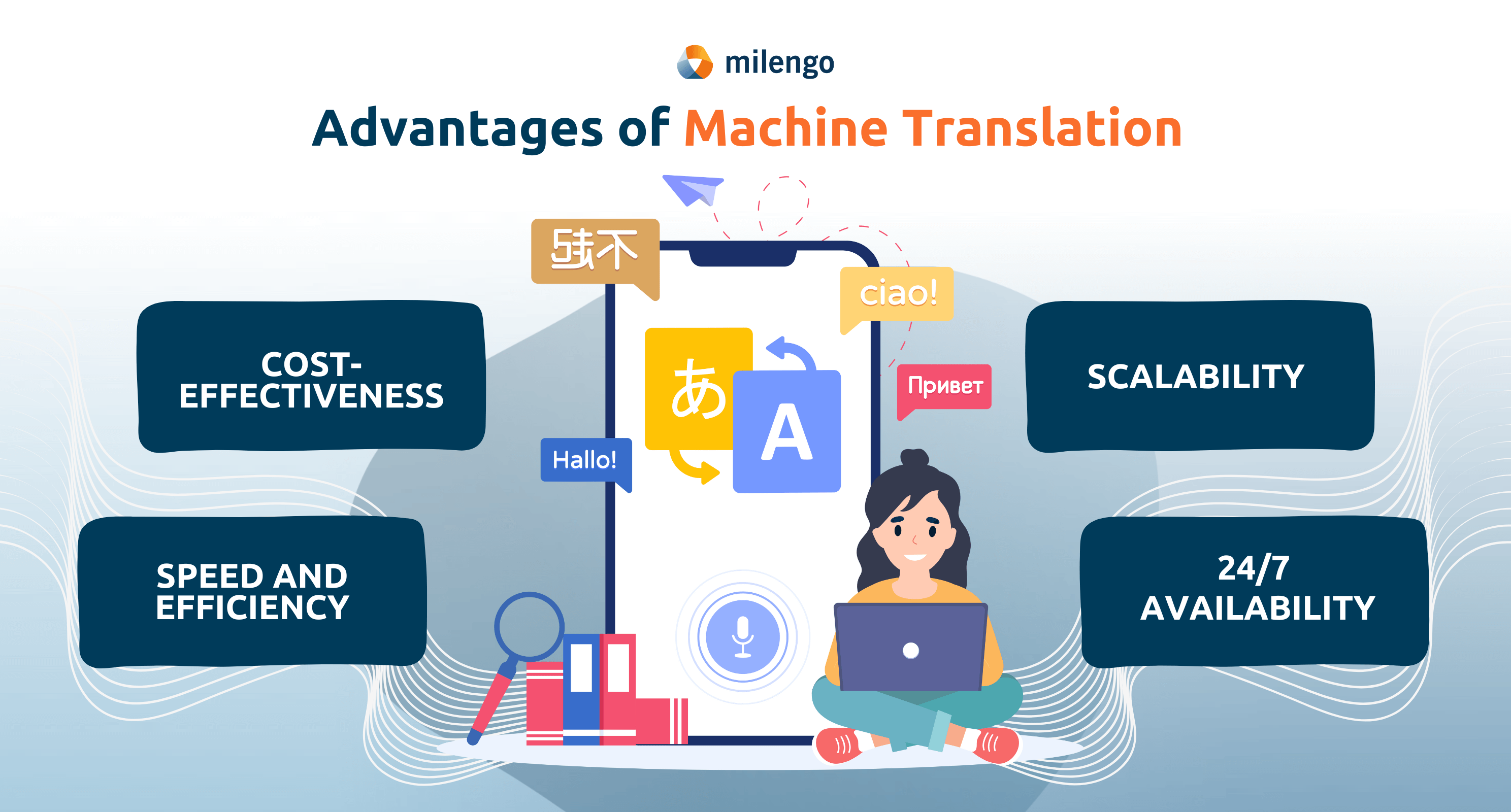How to Choose Between Machine Translation vs Human Translation

For decades, societies and corporations have relied on humans to assist with translating audio and texts between languages. However, in the age of technology and AI, getting market-ready translations of large volumes of content is now faster and cheaper than ever before, thanks to the development of machine translation (MT).
The technology has had a profound impact on the translation industry, leading to countless discussions and debates about its future, including:
- What are the benefits of machine translation vs human translation
- Can machine translation can replace human translations
- When to use which type of translation
This article compares the uses and benefits of both translation methods to help you understand the potential of each translation method and determine which you should use to take your company global.
Going global and need help to streamline multilingual content production? Milengo’s experts can help you figure out the best localization strategy for your company.
Machine Translation
The introduction of neural machine translation and more recently the use of generative AI and large language models (LLMs) for translations were turning points in the localization industry. These technological developments have massively enhanced machine translation quality from robotic word-for-word translations to outputs that are fluent and capable of understanding the context of sentences.
In fact, it is not uncommon for translators to incorporate machine translations in their workflows as well. Here is a look why some companies opt to use machine translation services.

Advantages of machine translation:
- Speed and efficiency – Machines can translate thousands of words in a matter of seconds, a feat that would be impossible for a human translator to achieve. This is particularly helpful for translating large volumes of texts, especially when you have tight deadlines.
- Cost-effectiveness – The sheer speed at which machines can translate texts mean that the cost per word is much lower than that of a human translator.
- Scalability – Machine translation engines can translate a range of language pairs. For instance, Google Translate can translate 133 languages. On the other hand, human translators specialize in one or a few languages. This minimizes the need to source for and manage an increasing number of resources for translation projects.
- 24/7 Availability – Machine translation software can operate around-the-clock. This allows translations to be delivered faster as it eliminates the need to wait for a translator’s availability.
We needed the highest quality translation in the shortest time possible. Machine translation with post-editing has exceeded all our expectations, while also reducing our costs.
Yitzik Brenman, Sr. Manager, Documentation Snowflake
Learn more about how Snowflake uses Machine Translation
Human Translation
For years, human translators have dedicated themselves to bridging the gap between languages and cultures. Not just for businesses, but also for global relations. Even with the many advantages of machine translation, they possess the ability to convey meaning with a level of accuracy and understanding that machine translation often cannot match.
Below are some of the reasons why human translators are still crucial for the translation industry.

Unique abilities of human translators:
- Understanding context and nuances – Machines are often unable to grasp linguistic complexities such as idioms and sarcasm, leading them to be literally translated. Furthermore, texts need to be read within context to ensure translations match the intended meaning. For example in software localization or website translations where there are short blocks of texts for buttons.
- Cultural sensitivity – A good translation conveys not just words, but also cultural nuances. Humans have the advantage of living in the real world. This makes them able to understand cultural nuances and sensitivities, which machines are unable to.
- Creativity and tone – Machines translate based on pre-set rules that have been ‘tried and tested’. On the flipside, human translators are privy to linguistic semantics and the target audience. As a result, they can creatively choreograph words and tonality to achieve the desired emotions and outcomes of a translation.
- Ability to handle complex projects – Some content types require industry experts and specialists to ensure nuances in languages are captured properly. Common instances include: marketing materials such as website headlines often need to convey specific emotions, which machines are unable to capture. Industry experts are also often required for legal or engineering documents to ensure terminology is used correctly and consistently.
Machine Translation vs Human Translation
Now that we’ve covered the benefits of each method of translation, let’s have a look at differences of both methods side by side to get a clearer picture of where the strengths and weaknesses lie.
| Factor | Machine Translation | Human Translation |
|---|---|---|
| Accuracy | Not 100% accurate due to inability to understand context. Struggles with nuances, connotations, and cultural sensitivities. | More accurate due to ability to understand context but might lack consistency in word usage. This can be solved with technologies like CAT tools and translation memory systems. |
| Cost | Cheaper than human translation | More expensive due to the process being more labor-intensive |
| Speed | Instantaneous translations | Slower than machine translations |
| Versatility | Depending on the engine used, can offer translations between 30 up to 133 language pairs | Specialized in a limited number of languages and industry domains |
| Adaptability | Limited adaptability. Relies on datasets to identify patterns and matches. Often struggles with uncommon phrases, slang, sarcasm, and cultural references. | Highly adaptable. Can adapt to different writing styles, tones, and target audiences. Understands the nuances of language, context, and cultural references. |
| Availability | Always-on | Needs to be sourced, and might not always be available |
Can machine translation replace human translation?
Machine translation is on the rise, taking on a growing share of translation work. However, there’s still a ways to go before machines can completely replace human translators. Raw machine translations can be clunky and error-prone, making them unsuitable for all situations. Furthermore, they are not suitable for all language pairs.
Machine translation post-editing (MTPE) bridges this gap perfectly. It combines the efficiency of machines with the expertise of humans to ensure top-notch translations. The process is straightforward: texts are first run through machine translation software. Then, human editors polish the output, guaranteeing accuracy, clarity, and correctness.
This isn’t the end of the story for human translators, though. As machine translation evolves, human involvement will likely shift towards a more consultative role. They’ll bring their experience and knowledge to the table, guiding the translation process and ensuring it aligns with specific needs.
How to Choose the Right Translation Method?
As we have seen, machine translation is more suited for certain types of content whilst human translators are better for others. Here’s a quick overview of instances when each type of translation is more suitable.
Machine Translation is best used for:
- Content that is not highly visible nor of high importance. For example: content where a general understanding would be sufficient, or information about a service or section of your business that does not contribute significant revenue or is being phased out.
- Factual and straightforward text such as product descriptions or news articles. Machine translation excels in objective, factual content that is written in simple language.
- Large volumes of content, such as user guides or software documentation, which would be too expensive for a human translator to work on due to the amount of time and therefore cost required.
Human translation works best for:
- Highly-visible content such as public-facing content that represents your brand.
- Creative translations (transcreation) which require factors such as tone, style, and the emotional message of translations to mirror the source text, as well as convey a cultural relevance to your target audiences.
- Critical documents where accuracy of translations takes priority over quick delivery. Examples of this include legal contracts, medical records, financial statements – anything with potential consequences for errors in translations.
- Highly technical content containing specific jargon or complex sentence structures. For such documents, a human translator can ensure accuracy and clarity.
The Bottom Line
Since machine translation and human translators have different strengths and weaknesses, it is important to remember that you have the option to use different translation methods for different content types.
These are some general rules we use at Milengo when analyzing the best way to structure our client’s translation projects with machine translation vs human translation. However, other critical factors such as your budget, timelines, and language pairs required will also impact your final choice.
Want personalized advice on how to structure your localization strategy to get the best quality translations at the best prices? Milengo can help you figure out the best way to set up your localization processes and get all the translations done too! Get a free consultation with our localization experts now.


